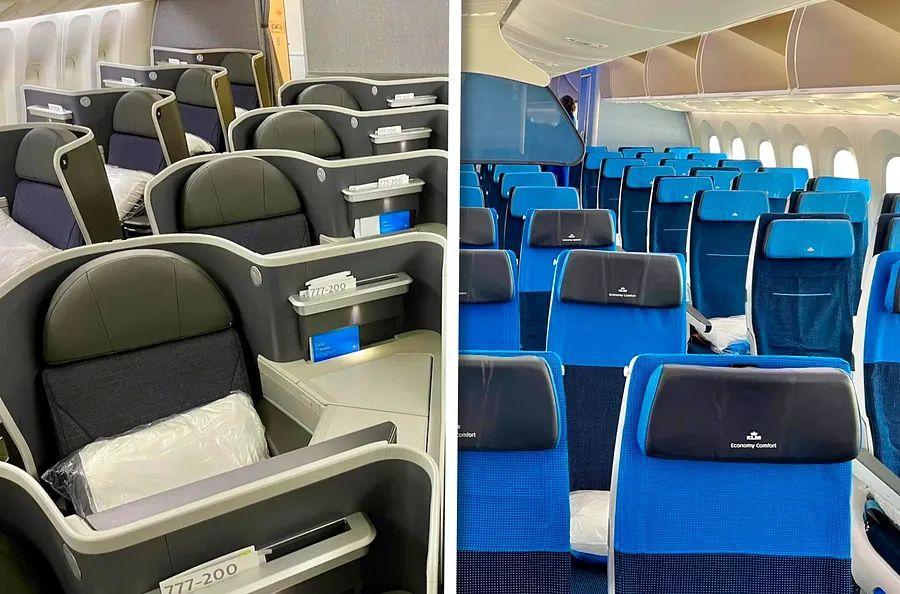Is upgrading from premium economy to business class worth it? Let's explore the differences.


While you might not recall the "golden age" of travel, the term "coach" likely rings a bell as the standard name for main cabin seating.
This sounds far more inviting than the often-used term "economy," which seems to dominate conversations these days.
As airlines keep making long-haul economy class increasingly uncomfortable, they are also enhancing the seats we often bypass on our way to cramped economy sections.
Whether it's enjoying a movie, listening to your favorite tunes, or meditating, these can help you cope with the current economy-class experience. But a stroll through business class might leave you pondering if you can splurge on a more spacious seat.
For many years, the sole upgrade option on most international flights was to business class. Recently, airlines have introduced a new category for long-haul journeys known as premium economy, or a variant unique to their brand.
An increase in seating choices means more price ranges and a broader array of perks. While this sounds appealing in theory, it's crucial to know what to anticipate in both premium economy and business class. Let’s examine each option closely.
What advantages does premium economy offer you?
Currently, premium economy sections are widely accessible on international flights, particularly with airlines like American Airlines, Delta Air Lines, and United Airlines.
One of the primary advantages of premium economy is the additional space. However, a typical premium economy seat doesn't differ much in size from an economy-class seat.
The most noticeable improvement is the space between your seat and the one next to you. You'll typically find a generous armrest separating you from your neighbor, reducing the chance of elbow clashes.
You'll also enjoy increased legroom. In premium economy, it's quite rare for your knees to bump against the seat ahead of you. Plus, you’re less likely to have someone tugging at your seatback to stand up (though there's usually one exception...).
Another advantage is the enhanced meal service found in almost all premium economy sections.
As airlines adapt their services now that the pandemic's peak appears to be over, premium economy meals have become noticeably more enticing.
However, it’s essential to keep your expectations in check. This is still airline food, after all. On longer flights, you can expect a hot meal initially, with many airlines providing similar menu options in both business class and premium economy.
In premium economy, you likely won't enjoy multiple courses or be served on china with silverware. However, the food quality should surpass that of economy class (assuming an economy meal is even provided).
On longer flights, most airlines provide a second light meal or snack before landing, but you probably won't receive any additional food during the journey.
While the remaining perks of premium economy may not be revolutionary, they are certainly nice to have. Airlines usually provide priority check-in and boarding, though lounge access is rarely included.
A higher baggage allowance is quite common, along with bonus miles on paid fares. Additionally, you’ll typically receive a basic pillow and blanket during your flight.
What benefits come with business class?
The business-class experience often begins even before you board the plane. As expected, most airlines offer priority check-in and boarding.
You'll likely gain access to a lounge before your flight, and possibly between connecting flights. The quality of business-class lounges can vary significantly, ranging from sparse snacks to à la carte menus and vintage Champagne. It’s wise to research these amenities before booking your flight.
Business class on international flights typically provides the best seating available on most airlines. While a few airlines still feature a genuine first-class experience (we're looking at you, Lufthansa), business class generally represents the peak of comfort.
Lie-flat seats and ample space are now standard in business class. Usually, each passenger has direct aisle access, although some newer configurations, like TAP Air Portugal's A320neo business class, may require window seat passengers to navigate over others to reach the restroom. Large flat-screen TVs offer a diverse range of entertainment options during your journey.
The bedding in business class is considerably more luxurious than in premium economy. A duvet and pillow are the norm, with some offerings, such as United's Polaris class, featuring cooling gel pillows and additional perks.
In summary, if you find it hard to sleep with the usual business-class bedding, you likely won't be able to sleep on planes at all.
Meal service in business class is far more extravagant than in premium economy. The initial meal often includes several courses and may feature special items like caviar and dessert carts.
You can typically choose from a selection of fine wines, and you'll find good to excellent Champagne available as well.
Overall, service in the business cabin is more attentive than in premium economy. Flight attendants are likely to check in frequently and offer drink refills several times during meal service.
On longer flights, a second meal service is generally provided, resembling the second meal or snack offered in premium economy.
Business-class travelers typically benefit from a higher checked baggage allowance and receive an amenity kit upon boarding.
These kits usually include necessities like eye masks, earplugs, toothpaste, and combs. Occasionally, the kits are impressive enough to be worth packing in your luggage, such as those made by Rimowa.
Moreover, business-class fares tend to earn significantly more miles compared to premium economy fares — and for good reason. You might be paying double to fly in the front of the plane.
Comparing prices between premium economy and business class
Booking extra space on your next flight can be quite expensive. Although this hasn't always been the case, the current fare disparities among economy, premium economy, and business class are among the most substantial we've seen in a long time.
Generally, upgrading to premium economy will set you back at least 50% more than an economy ticket. In many instances, you can expect to pay between 75% and 100% more.
For most long-haul flights, sitting in business class can cost at least 75% more than premium economy, with many popular routes demanding double the fare for a business class upgrade.
We examined fares for sought-after European destinations like London and Paris from U.S. cities such as New York and Washington.
Economy-class tickets were priced between $500 and $800 for round trips. Premium economy fares ranged from $1,100 to $1,600. Business class tickets started at $2,600 round-trip but could rise significantly for flights with preferred routing options.
If you're contemplating premium economy or business class, be sure to purchase your ticket with a credit card that offers bonus points for airfare bookings.
The Platinum Card® from American Express rewards you with 5 points for every dollar spent on airline tickets purchased directly from an airline or through Amex Travel, applicable to up to $500,000 in these purchases each calendar year. Additionally, with Bilt Rewards' new "Rent Day" promotion, you can earn 4 points per dollar on all travel expenses made on the first day of the month.
In summary: Is upgrading worth it?
Currently, upgrading to premium economy or business class for your next international flight can be quite costly.
There are a few important factors to weigh when making this choice. The duration and timing of your flight are definitely crucial considerations.
The longer your flight—especially if it's an overnight one—the more you’ll appreciate the extra space. This is particularly true if you opt for business class, where you can sleep more comfortably, though it will likely come at a high price.
If you're taking a short red-eye flight from New York to Iceland, the high price for business class doesn't seem as justifiable.
The cost of the upgrade should also be a significant factor in your decision.
Spending twice the price of an economy ticket for a marginally better meal and a bit more legroom can significantly impact your travel budget going forward.
Finally, consider whether there’s a more budget-friendly way to secure that upgrade.
Some airlines, like Hawaiian Airlines, offer you the option to bid for an upgrade to a premium cabin. Additionally, you might find that using miles to upgrade to premium economy or business class can be much more economical than paying cash.
Choosing to upgrade to premium economy or business class typically makes the most sense for the longest journeys.
Generally, you won't see much of a price variance based on flight duration. Thus, you'll receive the greatest value on lengthy flights to destinations in Europe, Asia, and South America.
Evaluation :
5/5



